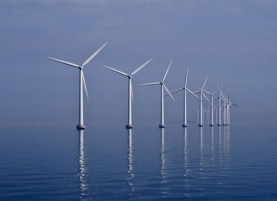
The unobstructed winds at sea are capable of spinning up enough power to electrify around 1 million German households.
Credit: Middelgrundens Vindmøllepark/Wikimedia Commons
ESBJERG, Denmark—Flying 56 miles west from this port, you are greeted by a 10-story, yellow, boxlike platform rising out of the North Sea. It is called SylWin1, the connection to Europe’s electric grid from one of the largest power plants ever built offshore. Beyond it, arrayed over 27 acres of ocean, are the 80 Siemens 3.6-megawatt turbines of the Dan Tysk wind farm.
For Europeans, and perhaps for some Americans, this may be their energy future. The unobstructed winds at sea here are capable of spinning up enough power to electrify around 1 million German households.
It’s an interesting sight to behold, not least because of the technical and engineering prowess required to overcome an often hostile North Sea environment. Yet in five years’ time, Dan Tysk might be outdated—if Siemens, MRI-Vestas, Dong Energy and other big corporate players in the […]












This looks like a BIG positive step for mankind. The USA better get in step with the smarter European counterparts.